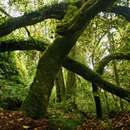en
names in breadcrumbs


Die witonderbos (Trichocladus ellipticus) is 'n klouterplant of klein boom. In Engels staan dit as die white witch-hazel bekend.[1]
Dit word in moerassige woudgebiede vanaf Mosselbaai tot in die noorde van KwaZulu-Natal, in die Drakensberge van Mpumalanga en die oostelike hooglande van Zimbabwe aangetref. In Suid-Afrika kom die ondersoort T.e. ellipticus voor. Dit is endemies aan Suid-Afrika en op die SANBI-rooilys word dit as veilig gelys.[2]
Hout: Wit, hard en taai, dikwels met 'n swart kern.[1]
Bas: Jong stamme, takkies en stingels is bedek deur fluweelagtige bruin hare, maar word volwasse tot 'n haarlose grysbruin kleur.[1]
Blare: Die blare is beide alternatief en spiraal gerangskik, ellipties tot lansetvormig, met 'n skerp punt en 'n effens meer geronde basis. Volwasse blare is donker, blinkgroen aan die bokant en ligter onder met digte, verroeste roomkleurige hare. Dit is gewoonlik 7 cm lank, maar kan wissel van 5 cm tot 15 cm in lengte, en 2,5 – 7,5 cm breed. Die blaarsteel is 0,5 – 2 cm lank.[1]
Blomme: Wissel in kleur van 'n gelerige groen tot roomkleurig. Die puntige, gegaafde okselstandige of terminale koppe is ongeveer 2 cm in deursnee, en lyk baie soos die Hamamelis s'n in vorm. Manlike en vroulike dele word op aparte blomme gedra, óf op dieselfde of verskillende eksemplare (kan óf eenhuisig of tweehuisig wees). Die plant blom van September tot Desember.
Vrugte: Klein, sag, amper sferiese 5x6cm kapsules wat verdeel in twee kleppe, wat elkeen in homself verdeel. Vrugte word tussen Desember en Februarie gedra.[1]
Die witonderbos (Trichocladus ellipticus) is 'n klouterplant of klein boom. In Engels staan dit as die white witch-hazel bekend.
Trichocladus ellipticus[1] maoy kaliwatan sa tanom nga bulak. Ang Trichocladus ellipticus kay sakop sa henero nga Trichocladus, ug pamilya nga Hamamelidaceae.[1][2]
Ang kaliwatan gibahinbahin ngadto sa matang nga nahiubos:[1]
Trichocladus ellipticus maoy kaliwatan sa tanom nga bulak. Ang Trichocladus ellipticus kay sakop sa henero nga Trichocladus, ug pamilya nga Hamamelidaceae.
Trichocladus ellipticus is a species in the genus Trichocladus, in the family Hamamelidaceae. It is also called white witch-hazel.[1]
An evergreen, Trichocladus ellipticus ranges in size from a scrambling shrub to a small, many-branched tree to 10m, while the subspecies malosanus reaches up to 15m. It is native to South Africa, eastern Zimbabwe, and western Mozambique along the border with Zimbabwe, where it occurs in mist-belt forests, along streams and rivers, where it is often quite dominant, and in swampy areas.[1]
Wood: White, hard, and tough, often with a black centre.[1]
Bark: Young stems are covered by velvety brown hairs, maturing to greyish brown and hairless.[1]
Leaves: Leaves are entire and are both alternate and spirally arranged, elliptic to lanceolate, with a pointed tip and slightly more rounded base. Adult leaves are dark, glossy green above with dense, rusty to cream coloured hairs beneath, and are normally 7 cm long, but can range from 5 cm to 15 cm in length, and 2.5-7.5 cm wide. Petiole is 0.5–2 cm long.[1]
Flowers: Ranging in colour from yellowish green to cream, the spiky, ragged axillary or terminal heads are about 2 cm in diameter, and closely resemble Hamamelis in shape. Male and female parts are borne on separate flowers, either on the same specimen or different specimens (may be either monoecious or dioecious). Flowers from September to December.[1]
Fruit: Small, velvety, almost spherical 5x6cm capsules which split into 2 valves, each of which itself splits into two. Fruits are borne between December and February.[1]
Trichocladus ellipticus subsp. ellipticus: Endemic to South Africa and has smaller, narrower leaves with an attenuate apex.[1] Trichocladus ellipticus subsp. malosanus:[1][2] Occurs in Zimbabwe and adjacent Mozambique, and has noticeably larger, broader leaves with a slightly rounded apex.[1]
Grows well in cool (temperate) greenhouses. Compost and care similar to that of Gardenia.[3]
Trichocladus is derived from Greek and means 'hairy-branched' (τριχός trichos, ‘hair’; κλάδος klados, ‘branch’),[3][4] while ellipticus, also derived from Greek (ελλειπτικός), means ‘about twice as long as broad, oblong with rounded ends, elliptic’.[4]
Trichocladus ellipticus is a species in the genus Trichocladus, in the family Hamamelidaceae. It is also called white witch-hazel.
Trichocladus ellipticus là một loài thực vật có hoa trong họ Hamamelidaceae. Loài này được Eckl. & Zeyh. miêu tả khoa học đầu tiên năm 1837.[1]
Trichocladus ellipticus là một loài thực vật có hoa trong họ Hamamelidaceae. Loài này được Eckl. & Zeyh. miêu tả khoa học đầu tiên năm 1837.